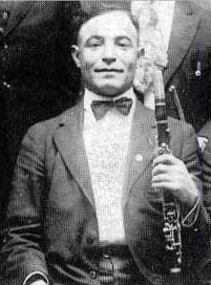Naftule Brandwein facts for kids
Quick facts for kids
Naftule Brandwein
|
|
|---|---|
 |
|
| Background information | |
| Born | 1884 Przemyslany, Austria-Hungary |
| Died | 1963 |
| Genres | Klezmer |
| Instruments | Clarinet |
Naftule Brandwein (born 1884, died 1963) was a very famous Klezmer musician. He was born in Austria-Hungary and later became an American citizen. Naftule was a talented clarinet player, a bandleader, and he made many recordings.
Many people think he was one of the best klezmer musicians of the 1900s. His music still inspires musicians today. He helped create the new American klezmer sound. This sound slowly became a more complex "big-band" style.
Contents
About Naftule Brandwein
His Early Life
Naftule Brandwein was born on September 20, 1884. This was in a place called Przemyslany, which was then part of Austria-Hungary. Today, this area is in Ukraine.
He came from a family of klezmer musicians. His family was part of the Stretiner Hasidic group. His father, Peysekhe, played the violin and clarinet. He was also a poet who improvised at weddings. Naftule had thirteen brothers. Many of them played instruments too. His brother Azriel played the cornet and was Naftule's first music teacher. Azriel had a big impact on Naftule's playing style.
Naftule married his wife, Dora. They had their first son, Moses. Soon after, they moved to America.
Moving to America
Naftule Brandwein came to the United States in April 1909. He sailed from Hamburg to New York City. His brother Israel was already living in New York. Naftule, his wife, and son settled nearby.
In 1912, he applied to become a US citizen. He started using the American name Nathan Brandwein. But in his music career, he was still known as Naftule. He officially became a US citizen in 1919.
His Music Career
When Naftule arrived in the US, he was already a very skilled clarinet player. He was good at promoting himself. This helped him become a well-known klezmer musician and bandleader.
He started recording music around 1920. At first, he played as a solo artist in other bands. In 1922, he began recording under his own name. He made klezmer dance tunes and special solo pieces called Doinas. He also recorded some Ukrainian music.
He recorded with famous companies like Columbia Records and Victor Records. He made many recordings from 1923 to 1927. These were mostly klezmer music, released as the Naftule Brandwein Orchestra.
From the mid-1920s, his career became a bit harder. People wanted different kinds of music. His traditional klezmer style was less popular. He went from being a top musician to playing in smaller venues.
He did return to the Victor Records studio in 1941. He recorded more klezmer dance pieces. By the 1950s, it was hard for him to get many jobs. He couldn't read sheet music. He also wasn't as comfortable with popular American music. Other musicians like Dave Tarras were better at adapting. Younger musicians like Sam Musiker and Max Epstein were also changing the music scene.
Even so, he kept working regularly. He played music almost until he died. Naftule Brandwein passed away in October 1963. He was 79 years old. He was buried in the Mount Hebron Cemetery in Flushing, New York.
His Unique Style
Naftule Brandwein was known for his colorful personality. He was also famous for his musical talent. Sometimes, he would wear a neon sign around his neck. It said "Naftule Brandwein Orchestra." He even played with his back to the audience. This was to hide his special fingering tricks.
He also wore plugged-in Christmas lights as part of his costume. One time, they shorted out because he was sweating too much! This almost gave him an electric shock.
His wild playing style mixed many kinds of Eastern European Jewish music. It was influenced by Greek, Turkish, Hungarian, and Gypsy music. His warm and lively playing was full of trills, slides, and other decorations. He was often compared to another famous klezmer clarinet player, Dave Tarras. Tarras had a different sound. Brandwein liked to take risks in his playing. He would often improvise and play a song differently each time.
His Lasting Legacy
Naftule Brandwein did not live to see klezmer music become popular again. This happened in the mid-1970s. But his music has been rediscovered by new klezmer musicians. They say he is a very important source of inspiration.
Some of the klezmer musicians influenced by him include David Krakauer, Hankus Netsky, Alicia Svigals, and Michael Winograd. Klezmer music traditions are not always written down in sheet music. So, his recordings are a main way people learn the "original" klezmer style.
Recordings
- 1997: King of the Klezmer Clarinet

